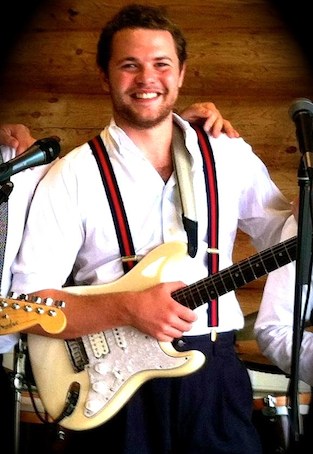May 14, 2019 by Klaus Crow
 Today I introduce to you George Ramsay, Co-founder and Guitar Teacher at Bold Music Lessons. George sheds light on combining pentatonics to play mixolydian.
Today I introduce to you George Ramsay, Co-founder and Guitar Teacher at Bold Music Lessons. George sheds light on combining pentatonics to play mixolydian.
A great example of how get the most out of your pentatonic scales. Learn and reap the benefits!
HERE’S GEORGE
You can’t really talk about soloing on the guitar without understanding pentatonic scales. Normal, or “full” major or minor scales have seven different notes, while pentatonic scales have only 5 notes (hence “pent”).
Klaus has written extensively on this as well as the CAGED system, so I’ll let you read through some of his postings for more info on playing these scales.
Today we will look at creating the Mixolydian scale by combining some major pentatonic with its parallel minor pentatonic.
Mixolydian is used extensively when improvising over the 12 bar blues, other I-IV-V chord progressions, and more generally chord progressions featuring dominant seventh chords.
What the heck is Mixolydian?
Mixolydian is a mode, and modes are really just types of scales, much like major and minor (in fact, major is called the Ionian mode and minor is called Aeolian). Perhaps the simplest way to understand modes is to look at a major scale. Let’s look at C major, where our notes are C-D-E-F-G-A-B-C.
Playing a major scale (in this case C major) but not starting or ending on C, creates our different modes. For example, the second mode, called Dorian (in this case D Dorian) would look like this: D-E-F-G-A-B-C. Similarly, the fifth mode, called Mixolydian, would have G-A-B-C-D-E-F as its notes. Notice that each of these modes consist of the same seven notes! We are just starting and ending in different places. These are modes.
Playing Mixolydian on the Guitar
The accomplished guitarist would argue the most practical way to look at these modes is to think of them as either some kind of major or some kind of minor scale. If you compare G Mixolydian with G major, you’ll notice that there is only one different note, F, so we can think of G Mixolydian as being a type of G major scale (G major= G-A-B-C-D-E-F#-G while G Mixolydian= G-A-B-C-D-E-F-G).
If we want to improvise using the Mixolydian scale, let’s first keep in mind that we are treating it as a type of major scale, and the major pentatonic always works over “major stuff.”
Interestingly, if we combine the G major pentatonic with the G minor pentatonic scale we will have all of the notes needed for Mixolydian—plus one more, but don’t worry, it sounds good too. Take a look:
G Mixolydian: G-A-B-C-D-E-F-G
G Major Pentatonic: G-A-B-D-E
G Minor Pentatonic: G-Bb-C-D-F
You’ll notice if we combine the two pentatonic scales, we are left with the following notes:
G-A-(Bb)-B-C-D-E-F.
As you can see, combining the G major and G minor pentatonic gives us all we need to play Mixolydian.
G Mixolydian
G Major Pentatonic
G Minor Pentatonic
Achieving the Mixolydian sound can be as simple as playing the G major pentatonic over the 12 bar blues and then every so often switching to G minor pentatonic. If you are familiar with the CAGED system, this should be quite simple.
Once you become familiar with switching in between the two pentatonic scales, you can begin to combine them (i.e. play a few notes from the major pentatonic followed by a few notes from the minor pentatonic) to further the bluesy, Mixolydian feel. Try this first over the blues in G, and see what you come up with! Of course, this can be applied to blues and dominant seventh chord progressions in any key as well.
That’s all for now—rock on!



Hi George sir,
I’m a beginner and I have never heard the term “Mixolydian”. This mixolydian thing is a new term to me. I’m gonna try these exercises. Since it is in tablature it is easy to play. Thanks for sharing.
Hi Klaus sir,
Thank you for creating the post “How to Hold a Guitar – Proper Posture and Hand Positioning”. Thank you for considering my request. I appreciate your kindness. Whenever I feel down I read your articles and obtain the motivation and energy to play. I got new energy after reading your blog. I continue guitar playing because of you and your articles.
Hi Prasana,
Glad I could help. Have fun playing and keep up the spirit. Remember you always have a choice in what you think. Think about the good things in life.
This is a really convenient way to think through how to play the Mixolydian mode. Should be a lot of fun switching between the two pentatonic scales.
Hi Prasana,
Thanks for your comment! The concept of Mixolydian comes from a larger conversation about these things we call modes. Modes are types of scales (like major and minor), and Mixolydian is simply one of those modes. Depending on the chord progression of a song, we can often “spice up” the feel by using modes other than straightforward major or minor scales. You see, the scales you can play when improvising entirely depend on the chord progression, and modes allow us to tackle these. Good luck!
Tom-
That’s exactly right- this is simply a convenient way to play the mixolydian mode. The simpler we can make complicated topics, the more applicable they become in our every day playing. Test this out on the 12 bar blues and see what you come up with. Rock on!